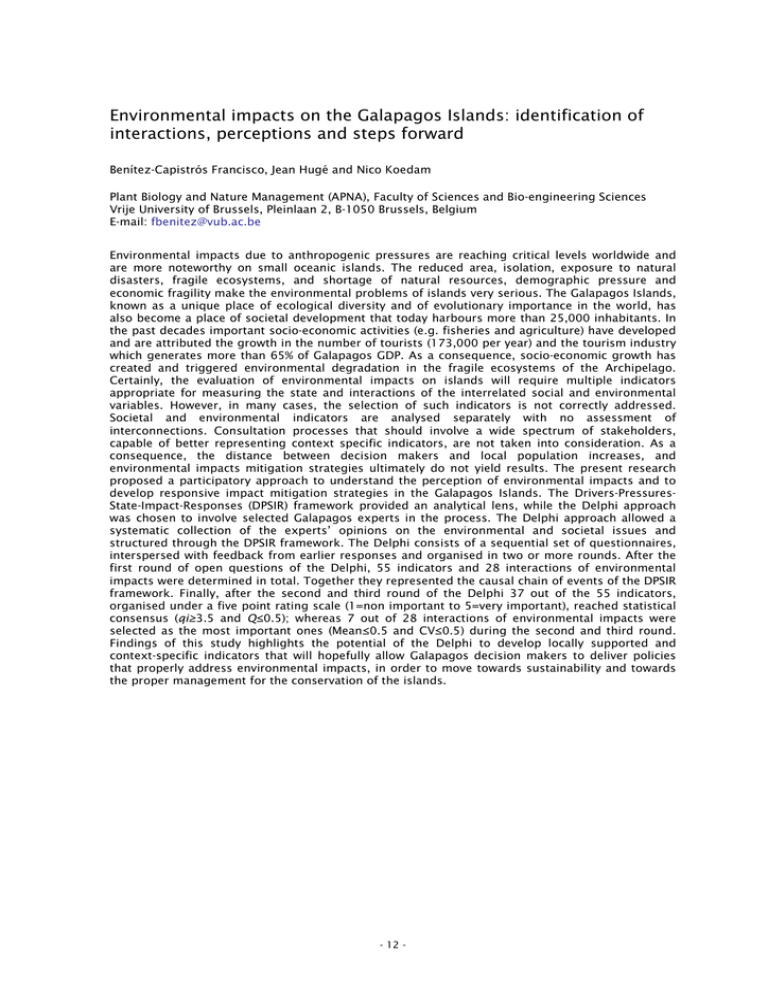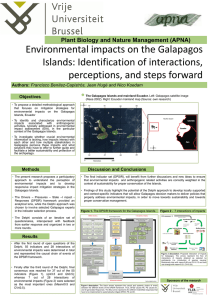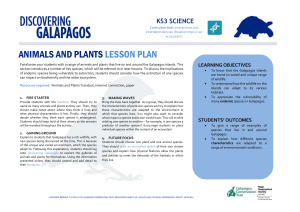Environmental impacts on the Galapagos Islands: identification of
advertisement

Environmental impacts on the Galapagos Islands: identification of interactions, perceptions and steps forward Benítez-Capistrós Francisco, Jean Hugé and Nico Koedam Plant Biology and Nature Management (APNA), Faculty of Sciences and Bio-engineering Sciences Vrije University of Brussels, Pleinlaan 2, B-1050 Brussels, Belgium E-mail: fbenitez@vub.ac.be Environmental impacts due to anthropogenic pressures are reaching critical levels worldwide and are more noteworthy on small oceanic islands. The reduced area, isolation, exposure to natural disasters, fragile ecosystems, and shortage of natural resources, demographic pressure and economic fragility make the environmental problems of islands very serious. The Galapagos Islands, known as a unique place of ecological diversity and of evolutionary importance in the world, has also become a place of societal development that today harbours more than 25,000 inhabitants. In the past decades important socio-economic activities (e.g. fisheries and agriculture) have developed and are attributed the growth in the number of tourists (173,000 per year) and the tourism industry which generates more than 65% of Galapagos GDP. As a consequence, socio-economic growth has created and triggered environmental degradation in the fragile ecosystems of the Archipelago. Certainly, the evaluation of environmental impacts on islands will require multiple indicators appropriate for measuring the state and interactions of the interrelated social and environmental variables. However, in many cases, the selection of such indicators is not correctly addressed. Societal and environmental indicators are analysed separately with no assessment of interconnections. Consultation processes that should involve a wide spectrum of stakeholders, capable of better representing context specific indicators, are not taken into consideration. As a consequence, the distance between decision makers and local population increases, and environmental impacts mitigation strategies ultimately do not yield results. The present research proposed a participatory approach to understand the perception of environmental impacts and to develop responsive impact mitigation strategies in the Galapagos Islands. The Drivers-PressuresState-Impact-Responses (DPSIR) framework provided an analytical lens, while the Delphi approach was chosen to involve selected Galapagos experts in the process. The Delphi approach allowed a systematic collection of the experts’ opinions on the environmental and societal issues and structured through the DPSIR framework. The Delphi consists of a sequential set of questionnaires, interspersed with feedback from earlier responses and organised in two or more rounds. After the first round of open questions of the Delphi, 55 indicators and 28 interactions of environmental impacts were determined in total. Together they represented the causal chain of events of the DPSIR framework. Finally, after the second and third round of the Delphi 37 out of the 55 indicators, organised under a five point rating scale (1=non important to 5=very important), reached statistical consensus (qi≥3.5 and Q≤0.5); whereas 7 out of 28 interactions of environmental impacts were selected as the most important ones (Mean≤0.5 and CV≤0.5) during the second and third round. Findings of this study highlights the potential of the Delphi to develop locally supported and context-specific indicators that will hopefully allow Galapagos decision makers to deliver policies that properly address environmental impacts, in order to move towards sustainability and towards the proper management for the conservation of the islands. - 12 -








